Falls in the bathroom lead to thousands of emergency room visits each year.
That’s where grab bars come in. In this article, we’ll provide you with the guidance you need in choosing the right grab bars that enhance your bathroom’s safety, functionality, and aesthetics.
1. ADA Compliance
It’s important to consider features that adhere to the guidelines set by the Americans with Disabilities Act (ADA). ADA-compliant grab bars have undergone thorough research, testing, and quality control to ensure they meet the highest safety and accessibility standards. (For the complete ADA guidelines, click the link to visit their website.)
ADA has set standards for grab bar placement in commercial and public settings, and throughout this article we will discuss the relevant ADA guidelines. Please note that there is NO need to adhere to these placement guidelines in a clients residential home, as they do not take into account their individual needs. Instead, place grab bars where they provide optimal support.
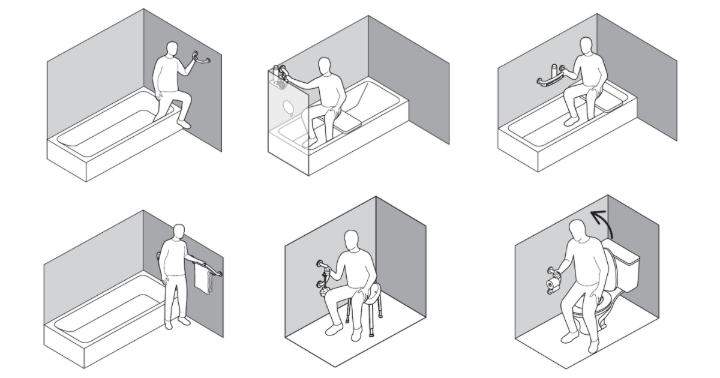
2. Right Length and Size
Choosing the right length and size of grab bars is essential for their functionality and effectiveness. Consider the dimensions of the bathroom and the specific areas where support is required. Ensure the grab bar is long enough to provide the necessary assistance and works for all members of the household who may use it.
ADA guidelines recommend
that grab bars must be easily gripped by the hand, typically 1 ¼-2 inches in
diameter for circular bars, or 2 inches in cross-section with a radius of 4-4.8
inches for non-circular bars.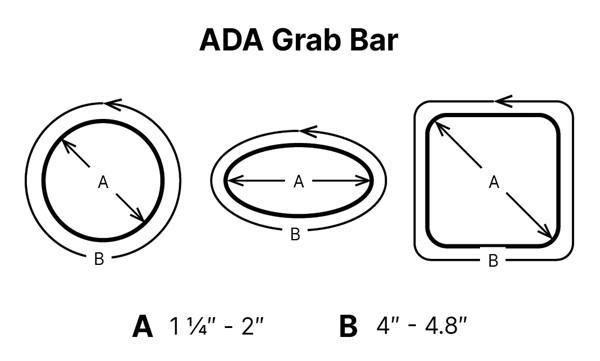
HealthCraft EasyMount straight grab bars are ADA-compliant and offer a range of sizes from 12” to 42” in length, ensuring you can find the perfect fit for your bathroom. They also come in a variety of finishes to match every decor. Our Invisia Collection and Plus Series of designer 2-in-1 grab bar accessories also meet these same ADA guidelines for grip size and weight capacity.
ADA guidelines also indicate length and placement of grab bars in the bathroom but these guidelines may not be relevant. Consider what works best for the client in their own home. The guidelines are as follows:
- Near the toilet: Side wall grab bars should be at least 42 inches long, while rear wall grab bars should be at least 36 inches long.
- In the bathtub and shower: Grab bars should be at least 24 inches long.
A better alternative would be to use a variety of grab bar accessories placed right where you need them to achieve the same type of support.
3. Easy Installation
When it comes to installation, it’s understandable to want a hassle-free experience. HealthCraft Easy Mount grab bars and PLUS Series are designed with 9-hole flanges, providing versatility and ease of installation into wall studs. Follow the instructions for proper installation to ensure maximum safety and stability. As per ADA standards, installed grab bars must be stable and must not rotate in their fittings.
If no wall studs exist where you need them, no problem. These grab bars are compatible with the HealthCraft Hollow Wall Anchor to provide easy installation exactly where you need them.
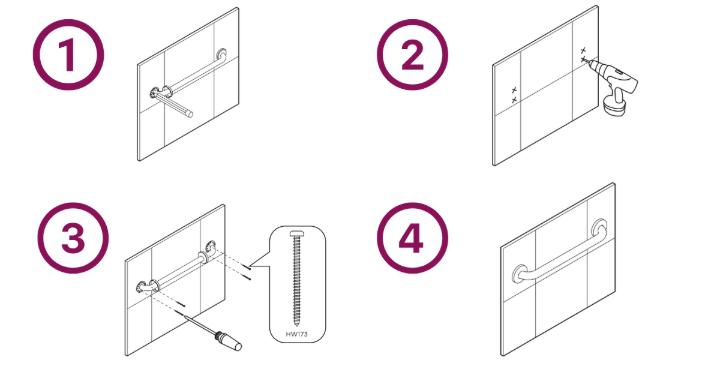
4. Weight Capacity
Consider the weight capacity of the grab bars you select to ensure they can support the needs of all users in the household. Manufacturers typically provide weight capacity information for their grab bars, ensuring you can choose one that meets your specific requirements. According to ADA guidelines, all components of grab bars, including fittings and support structures, must support a minimum of 250 lbs.
For those seeking greater reliability and peace of mind, HealthCraft’s EasyMount, PLUS Series and INVISIA Collection are designed to support up to 500 lbs. However, it’s important to note that certain installation factors can decrease the weight capacity of grab bars, especially when there is only a partial structure available for mounting.
When HealthCraft grab bars are installed using our Hollow Wall Anchor (without studs), they are designed to support up to 30 lbs in drywall, tile and drywall, or in acrylic tub surrounds.
5. Aesthetic Appeal
Who says safety has to come at the expense of aesthetics? Fortunately, there are grab bar options, that seamlessly blend safety with any style. Explore different finishes, such as black, white, brushed stainless, chrome, and oil-rubbed bronze, to complement bathroom decor.
If you are looking for something more discreet, consider HealthCraft’s PLUS Series and INVISIA Collection grab bars. These thoughtfully designed, innovative 2-in-1 accessories combine style and functionality. They provide a secure support surface while doubling as sleek, dual-purpose fixtures, making them the perfect solution for enhancing both safety and aesthetics.
Cleverly disguised as everyday bathroom accessories like toilet paper holders, shampoo shelves, towel hooks, and accent rings, these hidden grab bars provide an elegant and space-saving solution in any stylish bathroom setting.
For the most luxurious spa-like designs, look to the Invisia Collection when renovating a bathroom. They are designed with a discreet 3-point wall connection to deliver dependable support without sacrificing style. They require reinforcement in the walls and are not compatible with our Hollow Wall Anchor.
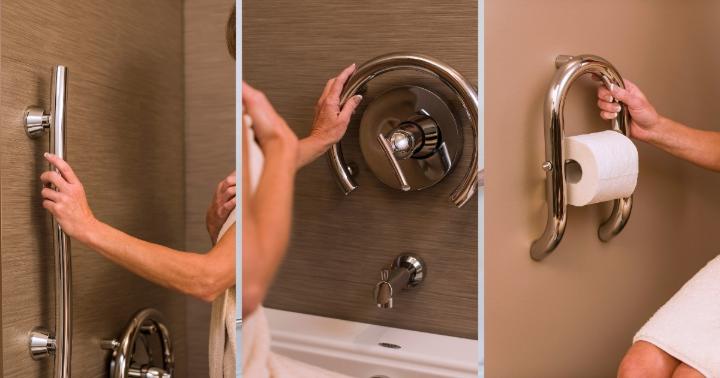
6. Expert Support
Occupational therapists can provide valuable assistance in assessing your clients specific needs in the home, and identifying what products might meet those needs. They can also assess the specific placement of supports that are customized for optimal safety in the home.
7. Proper Positioning and Right Quantity
Proper placement of grab bars is essential to maximize their effectiveness and ensure safety in the bathroom. Most importantly, you can put the grab bars where family members need them.
There are two high risk zones where most falls occur in the bathroom. One risk zone is at the toilet, and the other risk zone is around the tub /shower area. For more specific information on where to put grab bars in your bathroom, there are two detailed articles to help.
Most falls at the toilet occur when getting on and off the toilet. Falls can also happen when managing clothing before and after using the toilet. When getting up from the toilet, make sure that the support helps you to move forward onto your feet and as well as supports you as you rise up into a standing position. Grab bars disguised as toilet paper holders are the ideal accessory to help. If there are no walls beside the toilet, consider a floor-to-ceiling transfer pole like the SuperPole with SuperBar or folding support rails like the PT Rail.
ADA guidelines for grab bar placement in public and commercial spaces suggest that there should be at least 1½ inches of space between the bar and the wall to allow easy gripping. Any objects below and at the ends of the grab bar should maintain a 1½-inch distance to avoid obstruction, while objects above should be at least 12 inches above the top of the bar. The placement of the bars are indicated in the image below but may not be ideal in the clients home.
Grab bars in the shower:
The riskiest maneuver performed in the bathroom is stepping in and out of the tub or shower. While balancing on one leg and stepping with the other, our balance is compromised, and a slip or fall may occur. One bar to hold onto will help a little, but having two hand-holds is ideal to maintain balance and control your movements, especially when stepping into and out of wet slippery areas. Two-handed support is the best safety practice for you and your family members.
You might consider a towel bar grab bar or towel hook just outside the tub or shower area that they can hold onto when getting into or out of the shower. The bonus is the towel will be close by and they will avoid reaching for it. With a corner shelf and shampoo shelf placed strategically on the shower walls, they can have two accessories to hold onto when getting into or out of the shower. The added benefit is that they never have to bend down to get the shampoo off the shower floor.
The other time that our balance is significantly compromised in the shower, is when we close our eyes to let the water run over our face or to rinse the shampoo out of our hair. It is a good safety practice to have something to hold when you close your eyes and a shampoo shelf, or a corner shelf accessory might be just what is needed.
If your client gets down into the bottom of the tub for a bath, look for the spots where they would like support when moving between standing and sitting. Doing a dry run and using masking tape to mark where they place their hands, is the simplest way to see where support is needed.
If they use a shower chair for a safe seated shower, the preferred placement of a grab bar might be on a long diagonal to accommodate getting up and down from the chair as well as to hold the highest point when standing for some parts of the shower.
ADA guidelines for placement of grab bars in public and commercial spaces would indicate that two grab bars are needed along the long wall of the tub area as per the attached diagram. The grab bars in walk-in showers should be positioned 33-36 inches above the floor for optimal accessibility. However, put supports in the home, exactly where they are needed.
If you have limited wall space or face structural constraints for standard grab bars, consider a floor-to-ceiling grab bar like the SuperPole. This is another way to get support exactly where they need it.
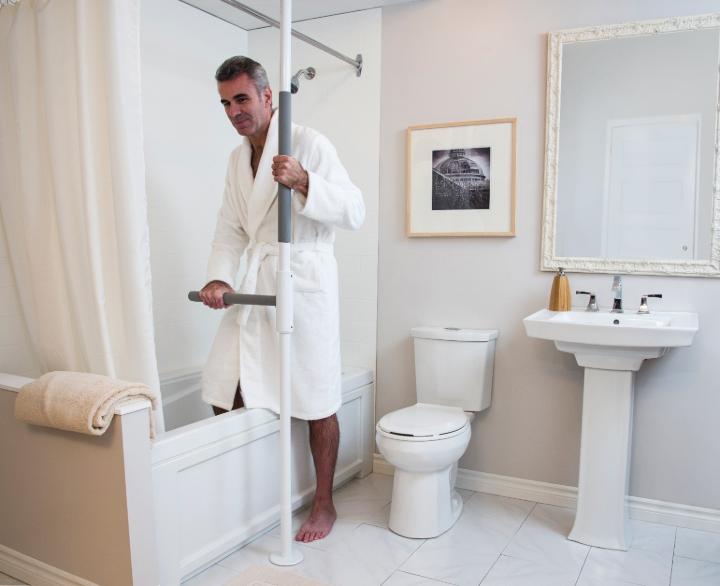
To learn more about grab bar options, and strategies to make your clients home safer, make you visit our Training Programs section.

About the Author:
Sandy Alexander B.Sc.(O.T.) is our Community and Clinical Education Specialist at HealthCraft Products. She comes to us after a rewarding 36 years as an Occupational Therapist. Sandy's passion for enabling function, adapting environments, and improving the quality of life for others, drives our mission at HealthCraft. She is spreading the message of Fall Prevention through local community events, industry conferences, and throughout our North American dealer network.